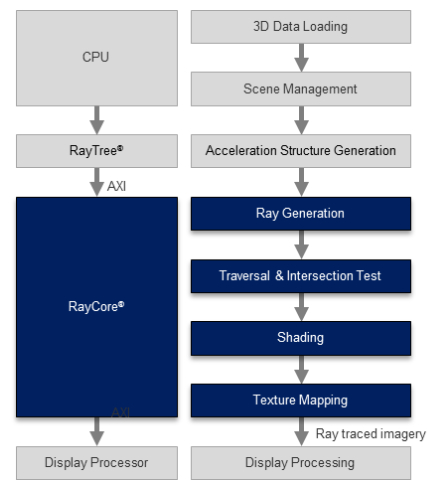AMBA Parameter Configurable Multi-Channel DMA Controller (typically 1 to 256)
Real-Time Ray Tracing GPU
RayCore GPU IP is designed based on MIMD architecture. This approach enables more efficient execution of independent parallel tasks – each ray is regarded as an independent instruction. Due to this advantage, RayCore GPU maintains ray tracing performance regardless of ray coherence and scene characteristics and consequently supports real-time ray tracing.
Among many advantages of RayCore GPU IP, its high degree of scalability and simple integration configuration enable it to enhance graphics performance linearly with increasing number of RayCore. Its cost-performance ratio guarantees superior graphics processing capability and low power consumption.
Through integration into today’s application processor, RayCore GPU IP offers unprecedented user experiences (e.g., dynamic customizable 3D UI, immersive 3D games, reality-like augmented reality, etc.) in a variety of devices including smartphones, tablets, handheld gaming devices, and TVs.
View Real-Time Ray Tracing GPU full description to...
- see the entire Real-Time Ray Tracing GPU datasheet
- get in contact with Real-Time Ray Tracing GPU Supplier
Block Diagram of the Real-Time Ray Tracing GPU IP Core

GPU IP
- 3D-like multicore GPU
- Ultra-low-power RISC-V based GPU Processor
- High-performance 2D (sprite graphics) GPU IP combining high pixel processing capacity and minimum gate count.
- 2D (vector graphics) GPU IP Further advanced architecture for minimized CPU load and increased pixel performance in vector processing
- 2D (vector graphics) & 3D GPU IP A GPU IP combining 3D and 2D rendering features with high performance, low power consumption, and minimum CPU load
- Shader architecture type 3D GPU Integrating the OpenVG 1.1 hardware processing pipeline








